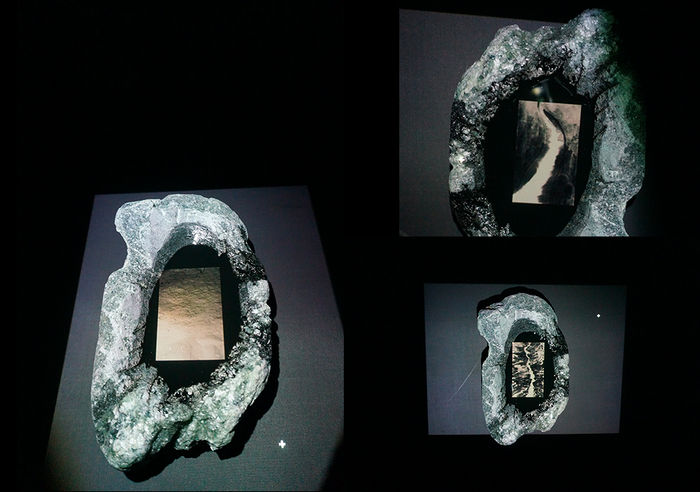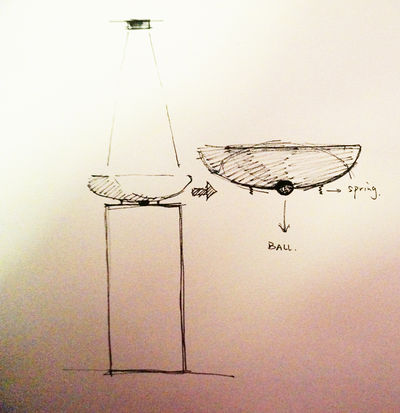User:Chen Junyu/Graduation Project Seminar/ project proposal/Proposal5
Research Question
Rosenberg has redefined art "art is an act rather than an object, as a process rather than a product”. Quoted from Drawing by Philip Rawson: It(Drawing) seems to have physical presence only as a static object. but its structure in fact is produced by actions carried out in time. However, from the aspect of appreciating a painting or drawing, it is difficult to truly reach the process of drawing/painting. My research question is base on this phenomenon-- how to make the process of drawing visible?
Project
The project is “ The Water”. The expected installation would be formed by three parts : a stone container which has a construction that response to the vibration of the environment, it will shake when the vibration reach a certain range. The ink in the stone container, and the projection of a drawing from the top of the container onto the surface of ink. I will use the material of Chinese ink and rice paper to approach the final drawing. The projection of the drawing should be in the same scale of the original one, and should be available to represent all the details of stroke and the texture of the paper.
When visitors walk around the installation, their steps will work on the vibration in environment thus trigger the shaking of the container. The ink should starts waving in the container. The projection of the drawing will move as the wave and change the image projected on the surface.
Context
The animation is visible dynamic. It is constructed by motions which rely on the phi phenomenon. Animators create the illusion of moving by drawing frame by frame and try to get the ideal movement to support the narrative. Drawing or painting is different type of art media. They are physically still. We can only read static information from a drawing or a painting. But if we think “dynamic” in another way, drawing/painting and animation somehow relate on in a fundamental level.
People have found examples of attempts to capture the phenomenon of motion into a still drawing in paleolithic cave painting. The animals in the paintings are usually have multiple legs in superimposed positions to convey the perception of dynamic. The paleolithic cave painting reflect the ancients’ understanding of motion and the desire of recording movement, in addition, it may also hint the consciousness of drawing things lively. In the Chinese painting theory “The Six principles of Chinese painting”(古画品录) written by art historian Xie He from six centuries, points out the “Spirit Resonance” or vitality is the overall energy of a work of art. It means that the lively representation either or both on depicting concrete objects or conveying the spirit of painter and generally a successful drawing should be able to transfer the dynamic atmosphere to the spectators. If we look at the action drawing, it presents a different meaning of “illusion of moving”. The physical act of painting becomes even more important than the final result of the work. The dynamic here refers to the emphasis of the act of drawing, the process of drawing or “The kinetic basis of drawing”( Philip Rawson, Drawing)
Compared with animation, the "dynamic" of drawing seems obscure and unreadable. "In appreciating drawings, no less than in making them, one has to be continuously aware of the character and qualities of the sequences which went into their composition. To get at these one has to look into the drawing carefully to find the order in which its parts were executed." "This quality of underlying movement is, of course, the special 'charm' of drawing which can never properly be carried over from drawing into a finished work of painting or sculpture."(Philip Rawson, Drawing). It is barely possible for spectators experiencing the "charm" of the dynamic and irreversible process from the final work. But is it possible to make a drawing which it alway keep the nature of "dynamic" visible?
For this project, the image spectators seeing is based on my drawing. While the waving of the ink, the projection of the drawing on the surface would keep changing its image . It is also irreversible. Every moment the current environment generate a new effect on the drawing, thus spectator will receive sequence of image which are reconstructed from my drawing by the dynamic environment. It can be read as the live animation, but in another way, the environment keep overlapping the unexpected strokes(wave) over the latest image. And spectators are also included in the process of drawing. It is the live drawing process which can always captured by viewers who at the same time also play the author of the drawing.
Preview works
"How to Draw a Perfect Circle"
Even though it is a work done for the group exhibition, I think it is the related to this project on thinking the relation between drawing and animation, also the usage of ink.
Prototypes
The projector projects the drawing from the top.
My first idea is through the wobbling of the surface, trigger the action of "drawing" proceed. But the question confused me now is:leave the act of drawing from me(or whoever drew this drawing, the next step is completed by the environment through the medium of water, can I still call it a "drawing"?
here it is the first prototype of the project. the sketch of the "wooble stone ball".
Work Survey
http://vimeo.com/72489795
Connecting cross country with a line, 2013 - Olafur Eliasson
http://vimeo.com/7915336 The Old Man and the Sea/
Literature Survey
Philip Rawson, Drawing
Lu Hong, The Formation and Development of New Ink Art in China http://www.mplusmatters.hk/inkart/paper_topic2.php?l=en
Xie He Six principles of Chinese painting 古画品录
Charlotte Mullins, PAINTING PEOPLE -figure painting today


